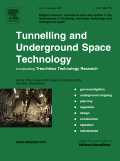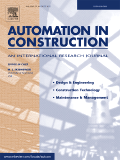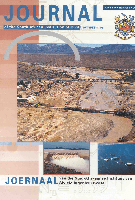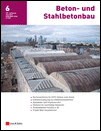
TUNNELLING AND UNDERGROUND SPACE TECHNOLOGY
Scope & Guideline
Unlocking the Future of Tunnelling and Construction.
Introduction
Aims and Scopes
- Tunneling Engineering and Technology:
Research on the design, construction, and maintenance of tunnels, including the development of new tunneling methods and technologies, such as TBM (Tunnel Boring Machine) advancements and innovative excavation techniques. - Geotechnical Engineering:
Studies on soil-structure interaction, ground stability, and the mechanical behavior of soil and rock masses during tunneling, including the analysis of geological hazards and their impacts on underground structures. - Fire Safety and Smoke Control:
Research focused on fire dynamics in tunnels, including smoke propagation, evacuation strategies, and the effectiveness of ventilation systems to enhance safety during fire incidents. - Environmental Impact and Sustainability:
Investigation into the environmental effects of tunneling projects, including noise, air quality, and energy consumption, as well as approaches to minimize the carbon footprint of underground construction. - Monitoring and Inspection Technologies:
Development and application of advanced monitoring techniques, including fiber optics and machine learning, for real-time assessment of tunnel conditions and performance. - Material Science and Structural Integrity:
Research on the properties and performance of materials used in tunnel construction, including the development of reinforced concrete, shotcrete, and innovative sealing technologies. - Risk Assessment and Management:
Analyses focused on identifying, evaluating, and mitigating risks associated with tunneling projects, including construction safety, ground settlement, and structural failures.
Trending and Emerging
- Digitalization and Smart Technologies:
An increasing number of studies focus on the integration of digital technologies, such as Building Information Modeling (BIM), AI, and IoT, to enhance the planning, monitoring, and management of tunneling projects. - Sustainability and Green Practices:
Research on sustainable tunneling practices, including the use of eco-friendly materials and energy-efficient construction methods, is gaining traction as environmental concerns become more prominent. - Advanced Monitoring Techniques:
There is a rising interest in advanced monitoring technologies, such as fiber optic sensing and machine learning algorithms, for real-time assessment and predictive maintenance of tunnel structures. - Fire Safety Innovations:
Emerging strategies for fire safety and smoke control in tunnels are becoming a focal point, with research exploring new ventilation designs and fire suppression systems. - Geotechnical Risk Management:
An increased emphasis on comprehensive risk assessment methodologies, particularly in relation to geotechnical hazards, is evident as projects become more complex and challenging. - Deep Learning and AI Applications:
The application of deep learning and artificial intelligence for predictive modeling and automation in tunneling processes is on the rise, showcasing the journal's alignment with cutting-edge research. - Resilience and Disaster Preparedness:
Studies addressing the resilience of underground structures against natural disasters and other emergencies are trending, reflecting a broader focus on safety and preparedness.
Declining or Waning
- Traditional Tunneling Methods:
There has been a noticeable reduction in papers focusing solely on conventional tunneling techniques, as newer technologies and methodologies gain prominence in the field. - Basic Theoretical Studies:
Research that focuses on fundamental theoretical aspects of tunneling without practical applications has decreased, as the journal's emphasis shifts towards applied research and technology. - Historical Case Studies:
The publication of historical case studies related to tunneling projects has diminished, possibly due to a greater interest in contemporary issues and innovations in the field. - Non-technical Aspects of Tunneling:
Topics related to non-technical aspects, such as socio-economic impacts or public perception of tunneling projects, have waned, reflecting a shift towards more technical and practical research.
Similar Journals

AUTOMATION IN CONSTRUCTION
Driving Efficiency and Innovation in the Construction IndustryAUTOMATION IN CONSTRUCTION is a premier academic journal published by Elsevier, dedicated to advancing the fields of Building and Construction, Civil and Structural Engineering, and Control and Systems Engineering. Since its inception in 1992, this journal has served as a vital platform for disseminating innovative research and practical applications in automation technologies within the construction industry. With a distinguished 2023 impact factor reflected in its Q1 ranking across multiple engineering categories—securing rank #3 in Civil and Structural Engineering and rank #3 in Building and Construction—AUTOMATION IN CONSTRUCTION stands out as a leading resource for researchers, professionals, and students keen on staying at the forefront of this rapidly evolving field. The journal offers access to cutting-edge studies that explore automation processes, methodologies, and tools, contributing to the enhancement of productivity and sustainability in construction practices. With contributions from global experts, each issue of AUTOMATION IN CONSTRUCTION provides comprehensive insights that help drive innovation and foster collaboration.

FIRE TECHNOLOGY
Pioneering Insights for Safer Materials and PracticesFIRE TECHNOLOGY is a prestigious peer-reviewed journal published by SPRINGER, focusing on the integral aspects of fire sciences and engineering. With its longstanding history from 1965 to 2024, the journal aims to advance the understanding of fire phenomena, enhancing safety and risk management practices in both engineering and materials science fields. Serving as an essential resource for researchers, professionals, and students alike, FIRE TECHNOLOGY currently holds a Q2 ranking in both Materials Science (miscellaneous) and Safety, Risk, Reliability, and Quality categories as per the 2023 Category Quartiles report. Additionally, it ranks #36 out of 207 in Safety, Risk, Reliability and Quality within Scopus, emphasizing its significant impact and reach in the scientific community. Although it operates under a traditional access model, FIRE TECHNOLOGY contributes invaluable knowledge that promotes the innovation of safer materials and practices in addressing fire hazards. Its dedicated focus continues to inspire advancements in fire technology and enhance societal safety, making it an indispensable publication for those invested in these critical fields.

Bauingenieur
Advancing Engineering Excellence in Building and ConstructionBauingenieur, an established journal in the field of Building and Construction and Civil and Structural Engineering, has been a significant platform for scholarly discourse since its inception in 1969. Published by VDI FACHMEDIEN GMBH & CO KG UNTERNEHMEN FACHINFORMATIONEN in Germany, this journal, available in both print (ISSN: 0005-6650) and electronic formats (E-ISSN: 1436-4867), serves as a vital resource for researchers, professionals, and students dedicated to advancing knowledge and practice in engineering. Although currently without open access options, Bauingenieur aspires to contribute to the academic community by presenting cutting-edge research, case studies, and technical reviews within the realms of construction and civil engineering. As evidenced by its categorizations in the 2023 Scopus rankings, where it has a Q4 designation in both relevant categories, it provides an essential resource for understanding current trends and challenges in the industry. The journal welcomes contributions that push the boundaries of knowledge and foster innovative solutions in the built environment.

Practice Periodical on Structural Design and Construction
Shaping the Built Environment with Insightful ResearchPractice Periodical on Structural Design and Construction, published by the American Society of Civil Engineers (ASCE), is a vital resource within the fields of civil and structural engineering. With an ISSN of 1084-0680 and an E-ISSN of 1943-5576, this journal aims to disseminate innovative research and practical applications that enhance the design and construction process. Recognized in the 2023 Scopus rankings with commendable placements across categories, including a Q2 designation in Building and Construction, this journal serves as a platform for discourse on the latest advancements and case studies in structural engineering. Though not an Open Access publication, it continues to facilitate the exchange of knowledge and expertise among researchers, professionals, and students engaged in the built environment. The editorial board encourages submissions that contribute to the understanding of sustainable practices, innovative technologies, and effective construction methodologies to meet the evolving needs of infrastructure development.

Fire Safety Journal
Pioneering research for a fire-safe future.Fire Safety Journal, published by ELSEVIER SCI LTD, is a premier interdisciplinary journal that disseminates cutting-edge research and innovation in the field of fire safety, risk management, and fire protection engineering. With an impressive impact factor reflecting its significance in multiple domains, including Chemistry (Q1), Materials Science (Q2), and Physics (Q1), this journal serves as a vital resource for researchers, practitioners, and policymakers dedicated to improving fire safety standards and minimizing risks associated with fire. The journal's ISSN is 0379-7112 and its E-ISSN is 1873-7226, ensuring broad accessibility and distribution within academic circles. Since its inception in 1977 and continuing through 2024, Fire Safety Journal has maintained a commitment to advancing knowledge and the sciences relevant to fire hazards, offering a platform for research that spans building construction, material safety, and risk analysis. As one of the highly regarded publications in its field with notable rankings across various categories in Scopus, the journal empowers a community of experts striving for innovation and excellence in fire safety.

PROCEEDINGS OF THE INSTITUTION OF CIVIL ENGINEERS-GEOTECHNICAL ENGINEERING
Pioneering Research in Geotechnical EngineeringPROCEEDINGS OF THE INSTITUTION OF CIVIL ENGINEERS-GEOTECHNICAL ENGINEERING, published by Emerald Group Publishing Ltd, is a prestigious journal that serves the dynamic field of geotechnical engineering and broader earth sciences. With an ISSN of 1353-2618 and an E-ISSN of 1751-8563, this journal has established itself as a vital resource for researchers, professionals, and students alike, offering insights into innovative practices and developments within the geotechnical domain. It ranks within the Q2 category for Earth and Planetary Sciences and Geotechnical Engineering as of 2023, demonstrating its significant impact and relevance in these fields. Given its comprehensive scope from 1994 to 2024, the journal provides a platform for high-quality research articles, case studies, and technical notes, although it presently does not offer open access options. Researchers seeking to publish their work will find this journal an essential venue for reaching an audience deeply invested in the advancement of geotechnical methodologies and solutions.

Journal of the South African Institution of Civil Engineering
Exploring sustainable solutions for modern challenges.Journal of the South African Institution of Civil Engineering (ISSN: 1021-2019) is a distinguished open-access publication dedicated to advancing the field of civil engineering in South Africa and beyond. Established by the South African Institution of Civil Engineering (SAICE) and South African Institute of Steel Construction (SAISI), it serves as a critical platform for sharing research, case studies, and industry developments. The journal has been openly accessible since 2015, ensuring broader dissemination of knowledge among researchers, professionals, and students alike. Although it currently holds a Q4 ranking in Civil and Structural Engineering and is positioned within the lower percentiles in Scopus rankings, its commitment to fostering growth in the engineering sector remains strong. Covering various topics from structural design to innovative construction methodologies, the journal invites contributions that push the boundaries of current practices and methodologies. This publication is essential for those invested in sustainable engineering solutions, aiming to collaborate and contribute towards the evolution of civil engineering standards in South Africa.

Beton- und Stahlbetonbau
Advancing Concrete Engineering KnowledgeBeton- und Stahlbetonbau is a renowned journal published by ERNST & SOHN, dedicated to advancing knowledge in the field of building and construction, particularly focusing on concrete and reinforced concrete engineering. Established in 1969, this peer-reviewed publication encompasses a broad range of topics, including innovative construction methods, structural analysis, and material performance, making it a crucial resource for researchers, scholars, and industry professionals alike. With an impact factor ranking it within the Q2 category in the Building and Construction field, this journal holds significant influence, evidenced by its Scopus rank of #112/223. Importantly, Beton- und Stahlbetonbau is committed to providing high-quality content that meets the academic rigor demanded by its audience, ensuring that readers remain at the forefront of technological advancements and research in concrete construction.

Stahlbau
Bridging Disciplines: Where Engineering Meets Innovation.Stahlbau is a prestigious journal published by ERNST & SOHN, focusing on the intersection of materials science, civil engineering, and mechanical engineering. With its roots dating back to 1968 and extensive coverage through 2024, this journal serves as a vital platform for the dissemination of innovative research and insights in the fields of Building and Construction, Civil and Structural Engineering, and Advances in Metals and Alloys. Despite its categorization in the Q3 quartile across several disciplines, it is recognized for its rigorous peer-reviewed articles and its commitment to advancing knowledge in structural engineering and materials' performance. The journal aims to foster a dynamic dialogue among researchers, industry professionals, and students, making it an essential resource for anyone looking to stay at the forefront of developments in construction and materials engineering. Access options reflect a commitment to intellectual exchange in academia, emphasizing the journal's role as a cornerstone for emerging research and best practices.

Gallerie e Grandi Opere Sotterranee
Unveiling Innovations in Underground EngineeringGallerie e Grandi Opere Sotterranee is a prominent scholarly journal published by PATRON EDITORE S R L, focusing on the interdisciplinary fields of architecture, archaeology, and civil engineering, particularly relating to subterranean structures and underground spaces. With the ISSN 0393-1641, this journal provides a platform for researchers and professionals to disseminate cutting-edge studies and innovative practices within the construction and preservation of underground galleries and monumental works. Although it does not currently offer open access, the journal is recognized for its rigorous peer-review process, enhancing the credibility and impact of the published research. Nestled in Bologna, Italy, it serves as a confluence for international scholars interested in advancing knowledge on subterranean architecture. By addressing the complexities of underground construction and conservation, the journal aims to foster collaborative dialogues among engineers, historians, and architects, making it an invaluable resource for anyone engaged in the subterranean domain.